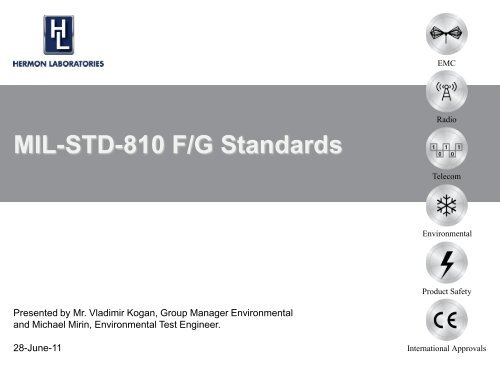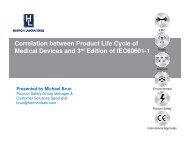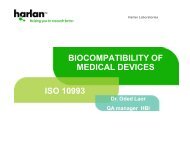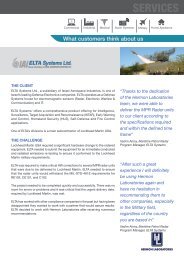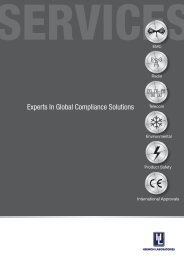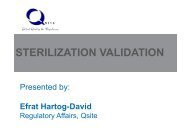MIL-STD-810 F/G Standards - Hermon Labs
MIL-STD-810 F/G Standards - Hermon Labs
MIL-STD-810 F/G Standards - Hermon Labs
You also want an ePaper? Increase the reach of your titles
YUMPU automatically turns print PDFs into web optimized ePapers that Google loves.
EMC<br />
<strong>MIL</strong>-<strong>STD</strong>-<strong>810</strong> F/G <strong>Standards</strong><br />
Radio<br />
Telecom<br />
Environmental<br />
Product Safety<br />
Presented by Mr. Vladimir Kogan, Group Manager Environmental<br />
and Michael Mirin, Environmental Test Engineer.<br />
28-June-11<br />
International Approvals
jpg. Files
Seminar AGENDA<br />
• <strong>MIL</strong>-<strong>STD</strong>-<strong>810</strong> introduction 09:00 – 09:30, Vladimir Kogan<br />
• <strong>MIL</strong> <strong>810</strong> overview – What it is<br />
• <strong>MIL</strong> <strong>810</strong> tests :Mechanical, Climatic, Special<br />
• <strong>MIL</strong> <strong>810</strong> F vs. <strong>MIL</strong> <strong>810</strong>G<br />
• Explosive Atmosphere 09:30 – 10:30, Vladimir Kogan<br />
• Scope, Purpose and Test Process<br />
• Break 10:30 – 10:45<br />
• Mechanical testing 10:45-11:30, Michael Mirin<br />
Scope, Purpose and Test Process<br />
• Altitude and Decompression test , 11:30 – 12:50, Vladimir Kogan<br />
Low, High Temperatures and Humidity testing<br />
Scope, Purpose and Test Process<br />
• Lunch break, 13:00-14:00<br />
• Explosive & Mechanical presentation/demonstration 14:00 -15:00<br />
• Explosive & Mechanical presentation/demonstration 15:00 -16:00<br />
• Q & A 16:00
<strong>MIL</strong>-<strong>STD</strong>-<strong>810</strong> F/G <strong>Standards</strong> Seminar<br />
WELCOME!
<strong>MIL</strong>-<strong>STD</strong>-<strong>810</strong> F/G Introduction
<strong>MIL</strong>-<strong>STD</strong>-<strong>810</strong> F/G Introduction<br />
Scope of the standard<br />
This standard contains materiel acquisition program planning and engineering direction<br />
for considering the influences that environmental stresses have on materiel throughout all<br />
phases of its service life. It is important to note that this document does not impose<br />
design or test specifications.<br />
“<strong>MIL</strong>-<strong>STD</strong>-<strong>810</strong>G, DEPARTMENT OF DEFENSE TEST METHOD STANDARD:<br />
ENVIRONMENTAL ENGINEERING CONSIDERATIONS AND LABORATORY TESTS<br />
(31 OCT 2008) – USA”
<strong>MIL</strong>-<strong>STD</strong>-<strong>810</strong> F/G Introduction<br />
Broad range of environmental conditions that include:<br />
• Low pressure for ALTITUDE testing;<br />
• Exposure to HIGH AND LOW TEMPERATURES plus TEMPERATURE SHOCK (both operating<br />
and in storage);<br />
• RAIN (including wind blown and freezing rain);<br />
• HUMIDITY,<br />
• FUNGUS,<br />
• SALT FOG for rust testing;<br />
• SAND AND DUST exposure;<br />
• EXPLOSIVE ATMOSPHERE;<br />
• LEAKAGE;<br />
• ACCELERATION;<br />
• SHOCK and transport shock (i.E., Triangle/sine/square wave shocks);<br />
• GUNFIRE VIBRATION;<br />
• RANDOM VIBRATION.
<strong>MIL</strong>-<strong>STD</strong>-<strong>810</strong> F/G Introduction<br />
History and rationale
<strong>MIL</strong>-<strong>STD</strong>-<strong>810</strong> F/G Introduction<br />
This standard is approved for use by all Departments and Agencies of the Department of<br />
Defense (DoD). Although prepared specifically for DoD applications, this standard<br />
may be tailored for commercial applications as well.<br />
• <strong>MIL</strong> <strong>810</strong>G includes significant changes vs. <strong>810</strong>F<br />
• One new additional Part<br />
• 5 New Test Methods
<strong>MIL</strong>-<strong>STD</strong>-<strong>810</strong> F/G Introduction<br />
The <strong>MIL</strong>- <strong>STD</strong> includes 3 parts
<strong>MIL</strong>-<strong>STD</strong>-<strong>810</strong> F/G Introduction<br />
Part 3:<br />
WORLD CLIMATIC<br />
REGIONS –<br />
GUIDANCE<br />
Part 2:<br />
LABORATORY TEST<br />
METHODS<br />
Part 1:<br />
ENVIRONMENTAL<br />
ENGINEERING<br />
PROGRAM<br />
GUIDELINES<br />
Describes management,<br />
engineering, and technical<br />
roles in the environmental<br />
design and test tailoring<br />
process.<br />
It focuses on the process of<br />
tailoring materiel design and<br />
test criteria to the specific<br />
environmental conditions a<br />
materiel item is likely to<br />
encounter during its service<br />
life
<strong>MIL</strong>-<strong>STD</strong>-<strong>810</strong> F/G Introduction<br />
Part One Environmental engineering program guide<br />
Task 401 - Environmental Engineering<br />
Management Plan (EEMP)<br />
Task 402 - Life Cycle Environmental Profile<br />
(LCEP)<br />
Task 403 - Operational Environment<br />
Documentation (OED)<br />
Task 404 - Environmental Issues/Criteria List<br />
(EICL)<br />
Task 405 - Detailed Environmental Test Plans<br />
(DETP)<br />
Task 406 - Environmental Test Reports (ETR)
<strong>MIL</strong>-<strong>STD</strong>-<strong>810</strong> F/G Introduction: Roles
<strong>MIL</strong>-<strong>STD</strong>-<strong>810</strong> F/G Life Cycle (Transportation)
<strong>MIL</strong>-<strong>STD</strong>-<strong>810</strong> F/G Life Cycle (Operational)
<strong>MIL</strong>-<strong>STD</strong>-<strong>810</strong> F/G Introduction<br />
Part 3:<br />
WORLD CLIMATIC<br />
REGIONS –<br />
GUIDANCE<br />
Part 2:<br />
Part 1:<br />
ENVIRONMENTAL<br />
ENGINEERING<br />
PROGRAM<br />
GUIDELINES<br />
Contains environmental<br />
laboratory test methods to<br />
be applied according to the<br />
general and specific test<br />
tailoring guidelines<br />
described in Part One.<br />
LABORATORY TEST<br />
METHODS
<strong>MIL</strong>-<strong>STD</strong>-<strong>810</strong>; 1962<br />
Test methods<br />
The <strong>MIL</strong>-<strong>STD</strong>-<strong>810</strong> test series contains environmental laboratory test methods that are applied using specific test tailoring<br />
guidelines described within the standard.
<strong>MIL</strong>-<strong>STD</strong>-<strong>810</strong> F/G : Part two Test methods “F”
<strong>MIL</strong>-<strong>STD</strong>-<strong>810</strong> F/G: Part two Test methods “G”
<strong>MIL</strong>-<strong>STD</strong>-<strong>810</strong> F/G: Part two Test methods comparison: 1962 vs. “G”
<strong>MIL</strong>-<strong>STD</strong>-<strong>810</strong> F/G Introduction<br />
Contains a compendium of climatic<br />
data and guidance assembled from<br />
several sources.<br />
Part 3:<br />
WORLD CLIMATIC<br />
REGIONS –<br />
GUIDANCE<br />
Part 1:<br />
ENVIRONMENTAL<br />
ENGINEERING<br />
PROGRAM<br />
GUIDELINES<br />
Part Three provides planning guidance<br />
for realistic consideration of climatic<br />
conditions in the research,<br />
development, test, and evaluation<br />
(RDTE) of materiel and materials used<br />
throughout their life cycles in various<br />
climatic regions throughout the world.<br />
Part 2:<br />
LABORATORY TEST<br />
METHODS<br />
It is intended that this and related<br />
documents will help achieve the<br />
objective of developing materiel that will<br />
perform adequately under the<br />
environmental conditions likely to be<br />
found throughout its life cycle in the<br />
areas of intended use.
<strong>MIL</strong>-<strong>STD</strong>-<strong>810</strong> F/G: Part three<br />
Areas of occurrence of climatic design types.
<strong>MIL</strong>-<strong>STD</strong>-<strong>810</strong> F/G: Part three<br />
Distribution of absolute minimum temperatures
<strong>MIL</strong>-<strong>STD</strong>-<strong>810</strong> F/G: Part three<br />
Distribution of absolute maximum temperatures
Explosive Atmosphere
Explosive Atmosphere<br />
Explosive Atmosphere test: Purpose<br />
The explosive atmosphere test is performed to:<br />
1. Demonstrate the ability of materiel to operate in fuel-air explosive atmospheres<br />
without causing ignition<br />
2. Demonstrate that an explosive or burning reaction occurring within encased<br />
materiel will be contained, and will not propagate outside the test item.
Explosive Atmosphere<br />
Application<br />
This method applies to all materiel designed for use in the vicinity of<br />
fuel-air explosive atmospheres associated with aircraft, automotive,<br />
and marine fuels at or above sea level.
Explosive Atmosphere: Limitations<br />
1. Conservative test<br />
If the test item does not ignite the test fuel-air mixture, there is a low probability that the<br />
materiel will ignite prevailing fuel vapor mixtures in service. Conversely, the ignition of the<br />
test fuel-air mixture by the test item does not mean the materiel will always ignite fuel vapors<br />
that occur in actual use.<br />
2. Altitudes above 16 km<br />
These procedures are not appropriate for test altitudes above approximately 16 km where<br />
the lack of oxygen inhibits ignition.<br />
3. High surface temperatures.<br />
This method is not intended to demonstrate ignition due to high surface temperatures.
Explosive Atmosphere: Effects<br />
Effects of explosive atmosphere environments<br />
Low levels of electrical energy discharge or electrical arcing by devices as simple as<br />
pocket transistor radios can ignite mixtures of fuel vapor and air.<br />
Fuel vapors in confined spaces can be ignited by a low energy discharge such as a<br />
spark from a short-circuited flashlight cell, switch contacts, electrostatic discharge,<br />
etc.
Explosive Atmosphere: Sequence<br />
Sequence among other methods<br />
Considering the approach to conserve test item life by applying what are perceived to<br />
be the least damaging environments first, generally apply the explosive atmosphere<br />
test late in the test sequence.<br />
Vibration, shock, and temperature stresses may distort seals and reduce their<br />
effectiveness, thus making ignition of flammable atmospheres more likely.<br />
Recommend the test item first undergo the above tests (on the same item) to better<br />
approximate the actual operational environment.
Explosive Atmosphere: Procedure Variations<br />
Selecting Procedure Variations.<br />
Before conducting this test, complete the tailoring process by selecting specific<br />
procedure variations (special test conditions/techniques for this procedure) based on<br />
requirements documents, Life Cycle Environmental Profile (LCEP), and information<br />
provided with these procedures.<br />
Fuel<br />
Unless otherwise specified, use n-hexane as the test fuel, either reagent grade or 95 percent n-<br />
hexane with 5 percent other hexane isomers. This fuel is used because its ignition properties in<br />
flammable atmospheres are equal to or more sensitive than the similar properties of 100/130-<br />
octane aviation gasoline, JP-4 and JP-8 jet engine fuel. Optimum mixtures of n-hexane and air will<br />
ignite from temperatures as low as 223°C, while optimum JP-4 fuel-air mixtures require a minimum<br />
temperature of 230°C for auto-ignition, and 100/130 octane aviation gasoline and air requires<br />
441°C for hot-spot ignition. Minimum spark energy inputs for ignition of optimum fuel vapor and air<br />
mixtures are essentially the same for n-hexane and for 100/130-octane aviation gasoline. Much<br />
higher spark energy input is required to ignite JP-4 or JP-8 fuel-air mixtures. Use of fuels other<br />
than n-hexane is not recommended.
Explosive Atmosphere: Procedure Variations<br />
Temperature<br />
Heat the fuel-air mixture to the highest ambient air temperature at which the materiel is<br />
required to operate during deployment and provide the greatest probability of ignition.<br />
Altitude simulation<br />
The energy required to ignite a fuel-air mixture increases as pressure decreases. Ignition energy<br />
does not drop significantly for test altitudes below sea level. Therefore, unless otherwise<br />
specified, perform all tests with at least two explosive atmosphere steps, one at the<br />
highest anticipated operating altitude of the materiel (not to exceed 12,200 m (40,000 ft.) where<br />
the possibility of an explosion begins to dissipate), and one between 78 and 107 kPa which is<br />
representative of most ground ambient pressures.<br />
Because of the lack of oxygen at approximately 16 km, do not perform this test at or above this<br />
altitude.
Explosive Atmosphere: Procedure Variations<br />
Fuel-vapor mixture<br />
Use a homogeneous fuel-air mixture in the correct fuel-air ratios for the explosive atmosphere test.<br />
Fuel weight calculated to total 3.8 percent by volume of the test atmosphere represents 1.8<br />
stoichiometric equivalents of n-hexane in air, giving a mixture needing only minimum energy for ignition.<br />
Required information to determine fuel weight:<br />
Chamber air temperature during the test.<br />
Fuel temperature.<br />
Specific gravity of n-hexane<br />
Test altitude: ambient ground or as otherwise identified.<br />
Net volume of the test chamber (L)
Explosive Atmosphere Fuel Calculation<br />
Calculation of the volume of liquid n-hexane fuel for each test altitude:
Explosive Atmosphere: Test Facility<br />
Explosive atmosphere set up data sheet<br />
Chamber volume<br />
160 L<br />
Chamber dimension<br />
Ø 45 cm, depth 70 cm<br />
Chamber temperature<br />
ambient to +80°C<br />
Chamber altitude<br />
up to 20 km (65.617 ft) (55 mBar)
Explosive Atmosphere: Test procedure<br />
Preparation for test<br />
Before starting the test, review pretest information in the test plan to determine test details:<br />
procedures, test item configuration, test temperature and test altitude.<br />
Install the test item in the test chamber in such a manner that it may be operated and controlled<br />
from the exterior of the chamber via sealed cable ports.<br />
Unless permanently sealed (not to be opened for maintenance or other purposes), remove or<br />
loosen the external covers of the test item to facilitate the penetration of the explosive mixture. Test<br />
items requiring connection between two or more units may, because of size limitations, have to be<br />
tested independently. In this case, extend any interconnections through the cable ports.<br />
Operate the test item to determine correct operation.<br />
In all instances, operate the test item in a manner representative of service use.
Explosive Atmosphere: Test procedure<br />
Operation in explosive atmosphere<br />
Step 1. With the test item installed, seal the chamber and stabilize the test item and chamber inner walls<br />
to within 10°C below the high operating temperature of the test item.<br />
Step 2. Adjust the chamber air pressure to simulate the highest operating altitude of the test item (not to<br />
exceed12,200m) plus 2000 meters to allow for introducing, vaporizing, and mixing the fuel with the air.<br />
Step 3. Slowly introduce the required volume of n-hexane into the test chamber.<br />
Step 4. Circulate the test atmosphere and continue to reduce the simulated chamber altitude for at least<br />
three minutes to allow for complete vaporization of fuel and the development of a homogeneous mixture.<br />
Step 5. At a pressure equivalent to 1000m above the test altitude, verify the potential explosiveness of<br />
the fuelair vapor by attempting to ignite a sample of the mixture taken from the test chamber using a<br />
spark-gap device with sufficient energy to ignite a 3.82-percent hexane mixture. If ignition does not occur, purge the<br />
chamber of the fuel vapor and repeat Steps 1-4.
Explosive Atmosphere: Test procedure<br />
Operation in explosive atmosphere<br />
Step 6. Operate the test item and continue operation from this step until completion of Step 7. Make and<br />
break electrical contacts as frequently and reasonably possible.<br />
Step 7. To ensure adequate mixing of the fuel and air, slowly decrease the simulated chamber altitude at<br />
a rate no faster than 100 meters per minute by bleeding air into the chamber.<br />
Step 8. Stop decreasing the altitude at 1000m below the test altitude, perform one last operational check<br />
and switch off power to the test item.<br />
Step 9. Verify the potential explosiveness of the air-vapor mixture as in Step 5 above. If ignition does not<br />
occur, purge the chamber of the fuel vapor, and repeat the test from Step 1.<br />
Step 10. Adjust the simulated chamber altitude to the equivalent of 2000 m above site pressure.<br />
Step 11. Repeat Steps 3-7. At site pressure, perform one last operational check and switch-off power to<br />
the test item.<br />
Step 12. Verify the potential explosiveness of the air-vapor mixture as in Step 5, above. If ignition does not<br />
occur, purge the chamber of the fuel vapor, and repeat the test from Step 10.<br />
Step 13. Document the test results.
Explosive Atmosphere: Test procedure<br />
Operation in Explosive Atmosphere<br />
0 Test Altitude
Explosive Atmosphere test algorithm (only <strong>MIL</strong>-<strong>STD</strong>-<strong>810</strong> F/G)
Explosive Atmosphere: test results example<br />
Temperature and pressure at test altitudes 30kft to site level<br />
Explosion tests<br />
in the sampling tube
Mechanical tests
Mechanical tests: Vibration<br />
What is vibration:<br />
According to WWW Webster on-line, as of 1997, Main Entry:<br />
vi·bra·tion<br />
Pronunciation: vI-’brA-sh&n. Function: noun.<br />
Date: 1655<br />
1. a periodic motion of the particles of an elastic body or medium in alternately opposite directions from<br />
the position of equilibrium when that equilibrium has been disturbed (as when a stretched cord produces<br />
musical tones or particles of air transmit sounds to the ear)<br />
b : the action of vibrating : the state of being vibrated or in vibratory motion: as<br />
(1) : OSCILLATION (2) : a quivering or trembling motion : QUIVER<br />
2. an instance of vibration<br />
3. vacillation in opinion or action : WAVERING<br />
4. a characteristic emanation, aura, or spirit that infuses or vitalizes someone or something and that can<br />
be instinctively sensed or experienced, often used in plural.<br />
b : a distinctive, usually emotional atmosphere capable of being sensed, usually used in plural<br />
- vi·bra ·tion ·al /-shn&l, -sh& -n&l / adjective<br />
vi·bra·tion·less /-sh&n-l&s/ adjective
Mechanical tests: Vibration<br />
Purpose of Vibration:<br />
Vibration tests are performed to:<br />
1. Develop materiel to function in and withstand the vibration exposures of a life cycle including<br />
synergistic effects of other environmental factors, materiel duty cycle, and maintenance.<br />
2. Verify that materiel will function in and withstand the vibration exposures of a life cycle.<br />
Consumers expect and demand products of high quality and reliability. To fulfill these requirements we<br />
must consider vibration, since at some time in its life the product will be subjected to vibration. Poor<br />
mechanical design will result in mechanical failure and customer dissatisfaction which will add cost and<br />
reduce credibility.
Mechanical tests: Vibration
Mechanical tests: Reasons for Vibration Testing<br />
Some reasons for Vibration Testing<br />
- Reduce product development time<br />
- Ensure new products are fit for purpose<br />
- Reduce in-plant rework due to QA rejection<br />
- Reduce damage in transit and subsequent rejection by the customer<br />
- Reduce marginal or non-performance rejection under Warranty<br />
- Reduce legal costs and damage claims due to incorrect operation of the product<br />
- Maintain a good reputation for the company and its products<br />
- Maintain profit margins<br />
In a highly competitive world marketplace Vibration Testing makes good sense.
Mechanical tests: Sequence among other methods<br />
The accumulated effects of vibration-induced stress may affect materiel performance under other<br />
environmental conditions such as temperature, altitude, humidity, leakage, or electromagnetic<br />
interference (EMI/EMC). When evaluating the cumulative environmental effects of vibration and other<br />
environments, expose a single test item to all environmental conditions, with vibration testing<br />
generally performed first.<br />
If another environment (e.g., temperature cycling) is projected to produce damage that would make the<br />
materiel more susceptible to vibration, perform tests for that environment before vibration tests. For<br />
example, thermal cycles might initiate a fatigue crack that would grow under vibration.
Mechanical tests: Vibration Effects<br />
Effects of vibration environment<br />
Vibration results in dynamic deflections of and within materiel. These dynamic deflections and associated<br />
velocities and accelerations may cause or contribute to structural fatigue and mechanical wear of<br />
structures, assemblies, and parts. In addition, dynamic deflections may result in impacting of elements<br />
and/or disruption of function. Some typical symptoms of vibration-induced problems follow.<br />
1. Chafed wiring.<br />
2. Loose fasteners/components.<br />
3. Intermittent electrical contacts.<br />
4. Electrical shorts.<br />
5. Deformed seals.<br />
6. Failed components.<br />
7. Optical or mechanical misalignment.<br />
8. Cracked and/or broken structures.<br />
9. Migration of particles and failed components.<br />
10. Particles and failed components lodged in circuitry or mechanisms.<br />
11. Excessive electrical noise.<br />
12. Fretting corrosion in bearings.
Mechanical tests: Vibration environment categories
Mechanical tests: Type of Vibration - Sine<br />
Sine Vibration<br />
One of the most common vibration tests is a swept sine test. These tests, as they imply, are a test where<br />
the signal driven into the vibrator is a sine wave and the frequency of the sine wave will change with time<br />
i.e. it will sweep. The level or amplitude of the signal measured on the vibration table can be either<br />
Acceleration, Velocity or Displacement. However, the sensor measuring the vibration is normally an<br />
Accelerometer which produces an output proportional to Acceleration. The controller, however, can<br />
convert the signal from the accelerometer to Velocity (by integration) or Displacement (by double<br />
integration).
Mechanical tests: Type of Vibration - Sine<br />
The units used for sinusoidal vibration testing are:<br />
Frequency Hz or radians/second<br />
Displacement mm or inches peak - peak or peak<br />
Velocity m/s or in/sec peak<br />
Acceleration m/s² or gn peak<br />
Metric Units Imperial Units SI Units<br />
D = mm peak - peak D = in peak - peak D = mm peak - peak<br />
V = mm/s peak V = in/s peak V = mm/s peak<br />
A = gn peak A = gn peak A = m/s² peak<br />
F = Hz F = Hz F = Hz<br />
G = 9806.65 mm/s² G = 386.0885827 in/s² G = 1000 mm/s²<br />
= 3.141592654 = 3.141592654 = 3.141592654
Mechanical tests: Type of Vibration - Sine<br />
There must be hundreds, if not thousands, of swept sine test specifications, but whatever the test, it<br />
should define the following:<br />
1. The upper and lower frequency of the test,<br />
2. The level to be maintained at the appropriate frequency,<br />
3. The rate at which the frequency will sweep and whether it is logarithmic or linear.<br />
4. The duration of the test or the number of sweeps.<br />
In addition to the option that we have discussed (Sweep Sine), in which sine runs at certain velocity<br />
(sweep rate), there is also an option, where sine will “stand” a certain time in one frequency. This<br />
vibration is called Sine Dwell.<br />
There is also possibility to combine several frequencies in a single experiment, each frequency will be a<br />
certain time.<br />
Because sweep sine "running" at certain frequencies and any moment he is located at certain frequency,<br />
main use is for research - testing the product behavior, search for resonance frequencies (Resonance<br />
Search), and the goals like this.<br />
But there are also cases that sweep sine are used to complete an endurance and resistance tests of the<br />
product.<br />
As we said before, there is also sine dwell. He is used if we want to put load on certain frequencies,<br />
which were found problematic or suspected as those.
Mechanical tests: Type of Vibration - Random<br />
If we observe a structure which has several beams of different length and we excite the structure with a<br />
swept sine test, each beam will vibrate vigorously when excited by its unique resonant frequency.<br />
However, if we excite the same structure with a broad band random signal, we will observe that all the<br />
beams are vibrating vigorously which would tend to indicate that all of the frequencies are present at the<br />
same time. Well they are, and they aren’t. This may seem irrational. However if you consider that over a<br />
short period of time that several frequencies are present, but the quantity and phase of those frequencies<br />
is varying randomly it may make more sense. Time is the key to understanding random. In theory, you<br />
must consider an infinite period of time in order to produce a true spectrum analysis of a random signal.<br />
If the signal is truly random, it will never repeat.<br />
The equipment used to analyze random signals years ago employed electronic bandpass filters to<br />
separate and quantify each frequency. All modern spectrum analyzers now use a mathematical process<br />
known as an FFT (Fast Fourier Transform).
Mechanical tests: Random<br />
As a further explanation of random the following may help. The diagram below shows how sine waves of<br />
different frequencies can be summed to form a complex waveform.<br />
10Hz<br />
20Hz<br />
50Hz<br />
90Hz<br />
Sum<br />
0.1 sec
Mechanical tests: Random
Mechanical tests: Random
Mechanical tests: Random<br />
Figure and Break points for curves Composite two-wheeled trailer vibration exposure.
Mechanical tests: Random
Mechanical tests: Shock<br />
In field simulation tests were examined three general types of mechanical motion and force:<br />
1. Continuous and periodic (like sine vibration)<br />
2. Continuous, but not periodic (like random vibration)<br />
and the last type<br />
3. Not continuous and not periodic<br />
The nearest thing for this is a mechanical shock.
Mechanical tests: Shock<br />
A mechanical or physical shock is a sudden acceleration or deceleration caused, for<br />
example, by impact, drop, kick, earthquake, or explosion. Shock is a transient physical<br />
excitation.<br />
Purpose of Shock test:<br />
Shock tests are performed to:<br />
1. provide a degree of confidence that materiel can physically and functionally withstand the relatively<br />
infrequent, non-repetitive shocks encountered in handling, transportation, and service environments. This<br />
may include an assessment of the overall materiel system integrity for safety purposes in any one or all of<br />
the handling, transportation, and service environments;<br />
2. determine the materiel's fragility level, in order that packaging may be designed to protect the<br />
materiel's physical and functional integrity; and<br />
3. test the strength of devices that attach materiel to platforms that can crash.
Mechanical tests: Shock<br />
Effects of shock.<br />
Mechanical shock has the potential for producing adverse effects on the physical and functional integrity<br />
of all materiel. In general, the level is affected by both the magnitude and the duration of the shock<br />
environment. Durations of shock that correspond with natural frequency periods of the materiel and/or<br />
periods of major frequency components in input shock environment waveforms that correspond with<br />
natural frequency periods of the materiel will magnify the adverse effects on the materiel's overall<br />
physical and functional integrity.
Mechanical tests: Shock<br />
Sequence among other methods.<br />
Sequencing among other methods will depend upon the type of testing, i.e., developmental, qualification,<br />
endurance, etc., and the general availability of test items for test. Normally, schedule shock tests early in<br />
the test sequence, but after any vibration tests.<br />
(1) If the shock environment is deemed particularly severe, and the chances of materiel survival without<br />
major structural or operational failure are small, the shock test should be first in the test sequence. This<br />
provides the opportunity to redesign the materiel to meet the shock requirement before testing to the<br />
more benign environments.<br />
(2) If the shock environment is deemed severe, but the chance of the materiel survival without structural<br />
or functional failure is good, perform the shock test after vibration and thermal tests, allowing the<br />
stressing of the test item prior to shock testing to uncover combined vibration, and temperature failures.<br />
(3) There are often advantages to applying shock tests before climatic tests, provided this sequence<br />
represents realistic service conditions. Test experience has shown that climate-sensitive defects often<br />
show up more clearly after the application of shock environments.<br />
However, internal or external thermal stresses may permanently weaken materiel resistance to vibration<br />
and shock that may go undetected if shock tests are applied before climatic tests.
Mechanical tests: Shock types<br />
Classical shock pulses (mechanical shock machine). Unless the procedure requires the use of a<br />
classical shock pulse, the use of such a pulse is not acceptable unless it can be demonstrated that<br />
measured data is within the tolerances of the classical shock pulses. Only two classical shock pulses are<br />
defined for testing in the method – the terminal peak sawtooth pulse, and the trapezoidal pulse.
Mechanical tests: Shock types - sawtooth pulse
Mechanical tests: Shock types - trapezoidal pulse
Mechanical tests: Test facility - LDS V875 Shaker specification<br />
LDS V875 Electrodynamic Shaker<br />
System vibration force (kN) 35.6<br />
System max shock force (kN) 105<br />
Max acceleration sine peak (gn) 110<br />
System velocity sine peak (m/s) 1.8<br />
Displacement pk-pk (mm) 50.6<br />
Payload, max (kg) 600
Mechanical tests: Test facility – “Closed loop”
Mechanical tests: Test facility – Fixture requirements and design
Mechanical tests: Test facility – Fixture requirements and design
Mechanical tests: Test facility – Fixture requirements and design


